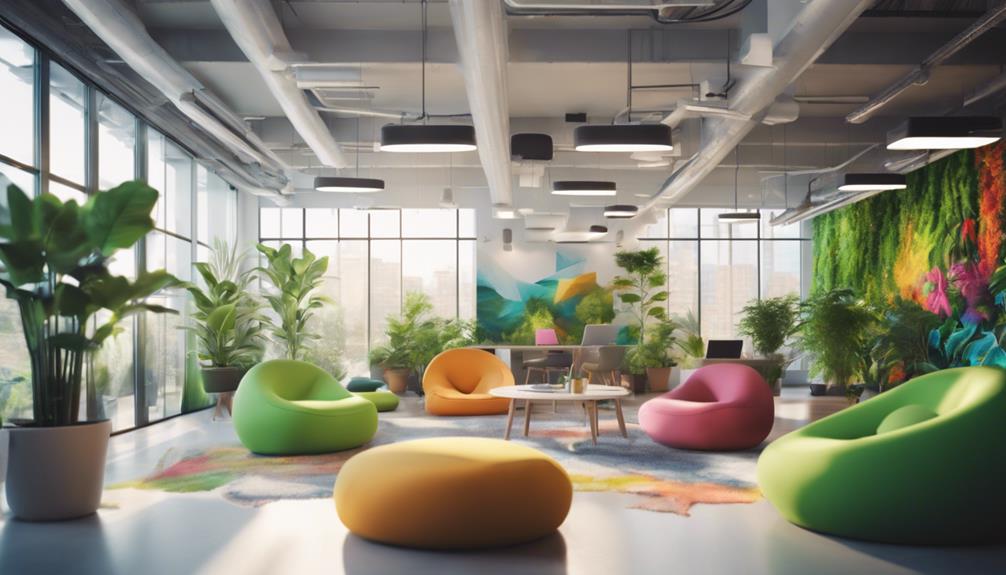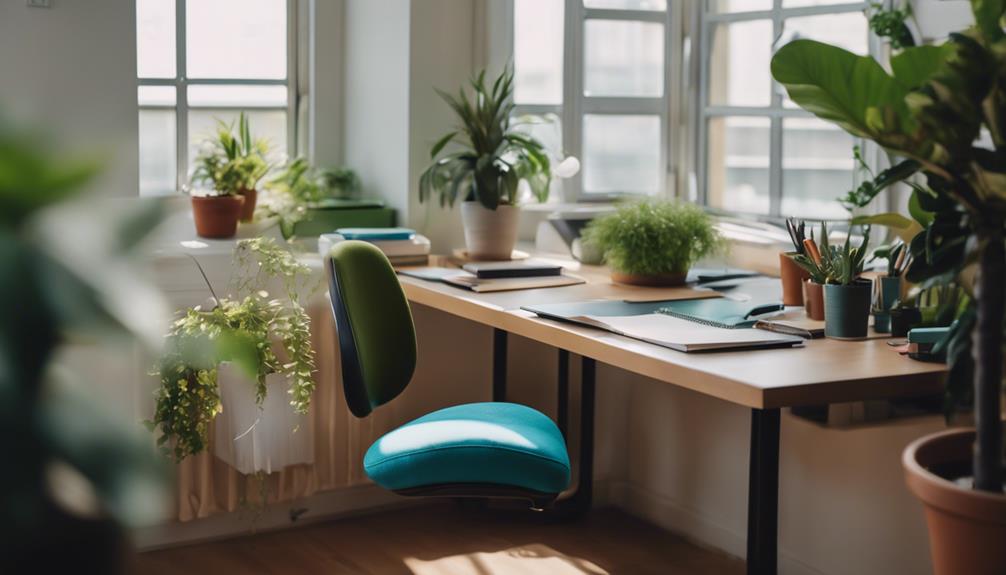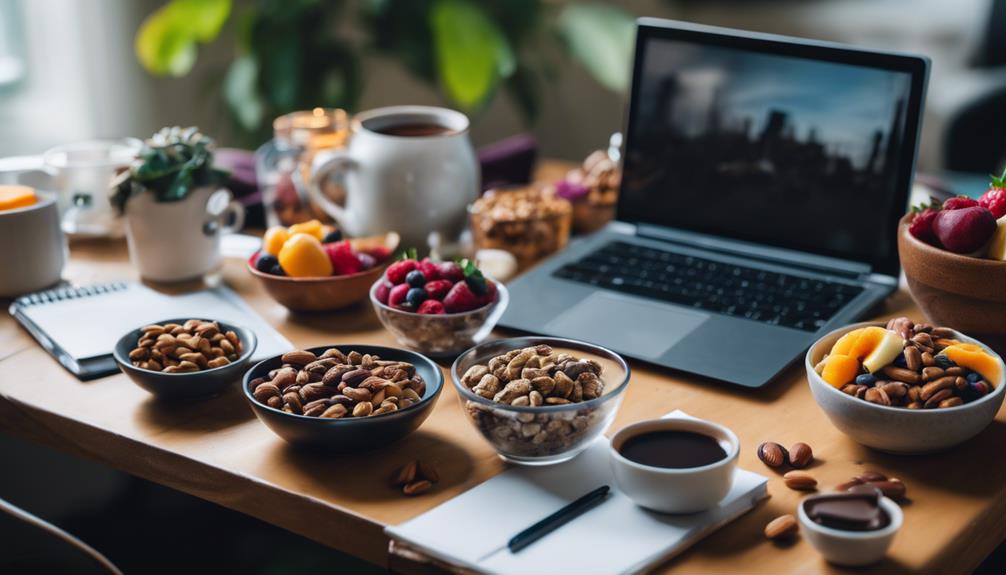I have discovered that incorporating effective office interior design can significantly improve productivity and creativity. To start, optimize your space with flexible furniture that can adapt to different needs. Adding ergonomic pieces can enhance comfort and reduce strain. Make sure to provide plenty of natural light, as it boosts mood and focus. Use colors that align with your brand to create an appealing aesthetic that promotes a positive atmosphere. Including greenery can help reduce stress and enhance well-being. Additionally, smoothly integrate technology to support collaboration and efficiency. By implementing these strategies, you can create an inspiring work environment. If you’re interested in exploring more innovative ideas, you can find even more helpful insights.
Key Takeaways
- Utilize flexible furniture solutions to create adaptable workspaces that accommodate various tasks and promote collaboration among employees.
- Incorporate natural light and greenery to enhance employee mood and reduce stress, boosting overall productivity and creativity.
- Design spaces with ergonomic furniture to support comfort and wellness, reducing strain and increasing focus during work hours.
- Ensure effective space utilization by implementing multi-functional areas and smart storage solutions for better organization and efficiency.
Space Planning for Commercial Office Interiors

For budding space planners and architect specialists, the 'Office Interior Design Ideas' resource offers crucial insights into effective space management and allocation in commercial office interiors.
I've found this resource to be an excellent guide, packed with up-to-date content that reflects current industry practices.
It highlights important aspects of Occupational Space Management, providing practical examples that help clarify complex concepts.
The emphasis on space allocation in relation to furniture placement is particularly useful.
However, while some visuals may come off as monotonous, the information itself remains highly ranked by users.
Overall, I believe that this resource can considerably enhance understanding and application of space planning, making it an essential tool for anyone looking to excel in this field.
Best For: Budding space planners and architect specialists seeking effective insights into commercial office space management.
Pros:
- Highly ranked by users, making it a trusted resource for both students and professionals.
- Practical examples provided throughout enhance understanding of complex space management concepts.
Cons:
- Some visuals may be perceived as monotonous and lack appeal.
- The dense content can make it challenging for some users to extract valuable insights.
Planning Office Spaces: A Practical Guide for Managers and Designers

Managers and designers looking to enhance their office environments will find 'Planning Office Spaces' an invaluable resource, bridging the gap between workplace culture and effective design strategies.
This guide is perfect for those without architectural training, as it simplifies the space design process. It helps managers like me rethink office layouts, offering practical examples and a clear framework for projects.
The book's well-organized content includes various office setups and effective graphics, making it easier to visualize concepts.
While some sections may seem overly detailed, the insights provided are relevant and current.
Overall, it's a solid reference for anyone involved in office space planning, ensuring that we can create inspiring and functional work environments.
Best For: Managers and designers seeking a practical guide to enhance office environments and streamline space planning without requiring extensive architectural training.
Pros:
- Well-organized content that covers various office setups with effective graphics and examples.
- Accessible for non-designers, providing practical insights and inspiration for office layout improvements.
Cons:
- Some sections may feel overly detailed, potentially overwhelming for readers seeking concise information.
- Certain topics may be less relevant for smaller office contexts, limiting applicability.
Beautifully Organized: A Guide to Function and Style in Your Home

Homeowners seeking to transform their spaces will find 'Beautifully Organized: A Guide to Function and Style in Your Home' an invaluable resource, offering practical solutions that blend organization with aesthetic appeal.
I've read this book multiple times, and each time, I discover new ideas that inspire me to tackle clutter in my own home. The author presents stylish, well-organized concepts, particularly in closet planning, which I found extremely helpful.
The friendly tone makes the advice feel accessible rather than patronizing. I appreciated the high-quality materials and binding, making it a beautiful addition to my bookshelf.
I even bought a copy for a friend struggling with organization, knowing it would motivate them just as it did for me.
Best For: Homeowners looking to declutter and enhance their living spaces with stylish organization solutions.
Pros:
- Offers practical and aesthetic organizing ideas that can be easily implemented.
- The friendly tone makes the advice accessible and motivating.
Cons:
- Some advice may come off as common sense for experienced organizers.
- The focus on an all-white aesthetic may not appeal to everyone's personal style.
MY BEDROOM IS AN OFFICE & OTHER INTERIOR DESIGN DILEMMAS /ANGLAIS

Anyone juggling the demands of remote work and personal space will find 'My Bedroom is an Office' a practical guide to transforming their living area into a functional and stylish workspace.
This book targets apartment dwellers and first-time homeowners, offering budget-friendly solutions for real-life design challenges. The flexibound format makes it easy to browse, while the eclectic images provide ample inspiration for organizing and enhancing bland spaces.
The Q&A format tackles common dilemmas, encouraging readers to customize their environments and create cohesive themes. Despite mixed reviews on originality, many appreciate the helpful tips for adapting to sudden changes in living situations.
Overall, it's a valuable resource for anyone looking to optimize their home office or spare bedroom.
Best For: Individuals living in apartments or first-time homeowners seeking budget-friendly design solutions for multifunctional spaces.
Pros:
- Practical advice tailored for real-life design challenges, making it accessible for everyday users.
- Eclectic images that inspire creativity and provide visual guidance for organizing spaces.
Cons:
- Some suggestions may be perceived as unoriginal, lacking fresh ideas for seasoned designers.
- Mixed reviews on the quality of visuals, with some readers finding them less impressive than expected.
Mr. Pen House Plan and Interior Design Templates – Set of 3

For architects and designers seeking precision in their projects, the Mr. Pen House Plan and Interior Design Templates offer essential drafting tools that streamline the design process. This set includes three templates: House Plan, Furniture, and Kitchen, Bed & Bath, all designed to scale at 1/4 inch = 1 foot. Made from flexible yet sturdy plastic, these templates are lightweight and easy to use.
The House Plan Template features vital symbols for appliances, doors, and plumbing fixtures, while the Furniture Template covers designs for various rooms.
Users have praised these templates for their versatility, making them ideal for everything from tiny homes to off-grid trailers. Overall, they enhance the efficiency and accuracy of any architectural project.
Best For: Architects, designers, and DIY enthusiasts looking for precise drafting tools to streamline their interior design projects.
Pros:
- Versatile templates suitable for various design projects, including tiny homes and off-grid trailers.
- Lightweight and flexible material that provides ease of use while maintaining durability.
Cons:
- Some users suggest thicker material for increased sturdiness.
- Limited scale options may not meet all user needs for different projects.
Your Creative Work Space Style Guide to Home Office Decor

Looking to transform your workspace into a haven of creativity and productivity?
I've found that creating a personalized home office can greatly enhance my work experience. Desha's book offers inspiring examples of various creative workspaces, from expansive studios to cleverly designed closets. It emphasizes that my workspace doesn't have to be perfect; it should reflect my individual personality and needs.
I appreciate the practical tips on desktop organization and setting up tailored creative spaces. The beautiful photography immerses me in these environments, making the ideas even more appealing.
While some critiques mention a lack of depth, I believe the motivational aspect alone makes it a worthwhile read for anyone looking to enrich their creative journey.
Best For: Individuals seeking inspiration and practical tips to personalize their home office and enhance creativity.
Pros:
- Beautiful photography that immerses readers in various creative workspaces.
- Practical style tips for desktop organization and tailored space setups.
Cons:
- Some readers find a lack of depth in the information provided.
- Repetitive themes across different workspaces may limit inspiration.
150 Best New Cottage and Cabin Ideas

If you're seeking fresh inspiration for a contemporary cabin, '150 Best New Cottage and Cabin Ideas' offers a stunning array of modern designs that captivated my imagination.
This book showcases an extensive collection of contemporary cabin styles from around the globe, making it a valuable resource for anyone interested in modern aesthetics.
I found the gorgeous photographs paired with detailed designs particularly appealing.
While the book focuses heavily on ultra-modern and minimalist styles, some may crave a broader range of options, like tropical designs.
Additionally, the inclusion of house plans alongside the visuals enhances understanding.
Overall, I recommend this book for those aiming to create a stylish, contemporary cabin, while others might prefer a more diverse selection.
Best For: This book is best for individuals seeking contemporary cabin designs that emphasize modern aesthetics and minimalist styles.
Pros:
- Gorgeous photographs that provide visual inspiration for modern cabin designs.
- Includes house plans alongside images, enhancing comprehension of the designs.
Cons:
- Focus on ultra-modern and minimalist styles may not appeal to those seeking traditional or diverse designs.
- Some readers feel there is a lack of substantial content in favor of visuals, affecting its overall utility.
150 Best Tiny Space Ideas

Tiny space ideas are perfect for those seeking to maximize functionality and style in compact living environments, offering innovative solutions that transform limited areas into beautifully designed havens.
I've found that utilizing multifunctional furniture is key; pieces like a sofa bed or an expandable dining table can save valuable space. Vertical storage solutions also work wonders; wall-mounted shelves and hooks keep items organized without consuming floor space.
Additionally, incorporating mirrors can create an illusion of depth, making the area feel larger. I've enjoyed exploring various aesthetics, from minimalist to cozy cottage vibes, all of which inspire creativity.
While some resources might lack detailed floor plans, the overall variety of designs makes tiny living both practical and visually appealing.
Best For: Individuals and couples looking to maximize space and creativity in small living environments.
Pros:
- Diverse inspirations cater to various aesthetics, making it easy to find a style that resonates.
- Multifunctional furniture ideas help optimize space and functionality.
Cons:
- Lack of detailed floor plans may disappoint those seeking more technical documentation.
- Quality concerns regarding the physical condition of the book can affect reader satisfaction.
Sketchup for Interior Design: 3D Visualizing, Designing, and Space Planning

For anyone enthusiastic to enhance their interior design skills, SketchUp offers an accessible and engaging way to visualize, design, and plan office spaces in 3D.
I've found that the book accompanying SketchUp provides step-by-step guidance, making it excellent for beginners and a useful reference for experienced users.
While some tutorials might assume prior knowledge, the clear introduction of tools helps demystify the software.
I often supplemented my learning with YouTube videos, which proved helpful.
Users appreciate the detail and accuracy they can achieve with SketchUp, making it a cost-effective alternative to expensive courses.
Overall, I've noticed a significant boost in my confidence and skills since I started using this resource, and I highly recommend it to others.
Best For: Beginners looking to enhance their interior design skills and experienced users seeking a detailed reference for SketchUp.
Pros:
- Provides step-by-step guidance and actual examples for effective learning.
- Engaging and clear introduction to tools, making it accessible for all skill levels.
Cons:
- Some tutorials may lack clarity and assume prior knowledge, which can be challenging for beginners.
- Users may need to rely on additional resources, like YouTube videos, for comprehensive understanding.
Create Your Dream Home on a Budget

First-time homeowners seeking practical yet stylish ways to design their office spaces on a budget will find 'Office Interior Design Ideas' an invaluable resource.
Daniel and Noell Jett, the authors, share their journey of creating a dream home while emphasizing careful planning. This book serves as a fantastic guide to decorating without breaking the bank.
It's organized by rooms, offering budgeting methods, styles, and sourcing tips. Each chapter includes step-by-step instructions for projects like painting, choosing wallpaper, and selecting storage solutions.
The stunning photographs enhance the reading experience, making the content both inspirational and practical. By promoting realistic expectations, the book helps dispel myths about quick transformations, ensuring that every homeowner can create a beautiful space within their budget.
Best For: First-time homeowners looking for budget-friendly decorating ideas and practical guidance for creating stylish spaces.
Pros:
- Comprehensive guidance on various home projects organized by rooms, making it easy to navigate.
- Stunning visual content that inspires creativity and enhances the reading experience.
Cons:
- May not cover ultra-modern styles or specific niche trends in depth.
- Some readers may find the budget constraints limiting for more extensive renovations.
The Interior Design Reference & Specification Book

The Interior Design Reference & Specification Book is an invaluable resource for both aspiring designers and seasoned professionals looking to enhance their office spaces with informed choices and innovative ideas. This book offers a wealth of organized information on essential topics like clearances, specifications, and lighting. Its neat design, premium pages, and stunning illustrations make it easy to navigate and understand.
I appreciate how it covers both foundational principles and advanced techniques, ensuring readers can apply the knowledge confidently. The focus on sustainability is particularly relevant today, guiding us toward eco-friendly materials.
Users have praised it as a treasure trove of inspiration, making it a must-have for anyone wanting to deepen their understanding of interior design.
Best For: The Interior Design Reference & Specification Book is best for students, professionals, and anyone interested in enhancing their knowledge and skills in interior design.
Pros:
- Provides organized and comprehensive information on essential interior design topics.
- Features stunning illustrations and a neat design that enhances the learning experience.
Cons:
- May be overwhelming for complete beginners due to the depth of information.
- Some readers might find the focus on advanced techniques less relevant to their needs.
Sooez Clipboard Folio with Refillable Notepad and Storage Pockets

With its multi-functional design and stylish Black Daisy finish, the Sooez Clipboard Folio is perfect for teachers and students looking to stay organized while adding a touch of elegance to their workspace.
This clipboard folio measures 12.8 x 9.7 inches and weighs just 1.65 pounds, making it easy to carry.
It features a low-profile metal clip that securely holds documents, while its twin wire spiral allows seamless switching between note-taking and clipboard use.
With five colored dividers and ten clear pockets, it provides excellent storage for letter-size papers.
The refillable notepad comes with 40 lined pages, ensuring I can keep taking notes without interruptions.
Overall, this versatile tool enhances productivity and offers a stylish organizational solution for anyone in need.
Best For: The Sooez Clipboard Folio is best for teachers, students, and professionals seeking an organized, stylish solution for note-taking and document storage.
Pros:
- Durable metal construction ensures long-lasting use.
- Multi-functional design combines clipboard, folder, and notebook features for added convenience.
Cons:
- Larger size may not fit standard bags or backpacks easily.
- Some users may find the weight slightly heavier compared to traditional clipboards.
Factors to Consider When Choosing Office Interior Design

When I'm choosing office interior design, I consider several key factors that can impact both the space and the people who work in it.
Efficient space utilization is vital, as it helps maximize productivity, while employee comfort and wellness are essential for a positive work environment.
Additionally, I think about branding, technology integration, and flexibility for future needs to guarantee the design adapts as my business evolves.
Space Utilization Efficiency
Effective office interior design hinges on how well you optimize space utilization, ensuring every square foot contributes to productivity and employee satisfaction.
I've learned that space utilization efficiency is all about making the most of what you have. By effectively planning the layout, I can boost productivity by 20-30%, as employees can easily access the resources they need.
Incorporating flexible workspaces, like hot-desking and shared meeting rooms, can also enhance space efficiency. This approach accommodates different team sizes and reduces areas that might otherwise go unused.
I've found that considering traffic flow and accessibility in my design choices can cut employee movement time by 15-25%. This creates a more cohesive working environment.
Additionally, using multi-functional furniture and smart storage solutions allows me to maximize smaller areas without sacrificing functionality. For instance, a desk that doubles as a meeting space can save valuable square footage.
Employee Comfort and Wellness
Prioritizing employee comfort and wellness in office interior design not only enhances productivity but also fosters a healthier work environment. To achieve this, I focus on several key factors.
First, ergonomic furniture is fundamental. It can greatly reduce musculoskeletal disorders and boost productivity by up to 17%. I make certain to provide chairs and desks that support proper posture.
Next, natural light plays an important role. Offices filled with sunlight can improve mood and energy levels, leading to a remarkable 51% reduction in eye strain and headaches. I also incorporate greenery and biophilic design elements, which can increase employee satisfaction and productivity by 15%, while reducing stress.
Air quality is another significant aspect. Well-ventilated offices can decrease absenteeism by 30% and enhance cognitive function by 61%. I guarantee that our spaces are equipped with proper ventilation systems.
Lastly, I address noise control. Using sound-absorbing materials and strategic layout planning can boost employee concentration by 48% and lower stress levels in open environments.
Branding and Aesthetic Appeal
Creating an office environment that prioritizes employee comfort naturally leads me to contemplate how branding and aesthetic appeal shape the overall workplace experience.
The interior design of an office should reflect the company's brand identity. This means incorporating colors, textures, and materials that align with the brand's values and mission. When the design resonates with the brand, it enhances employee morale and productivity. Studies show that aesthetics greatly impact workplace satisfaction and performance.
To improve aesthetic appeal, I find that elements of biophilic design, like natural light and greenery, are essential. These features not only beautify the space but also promote well-being and reduce stress among employees. The choice of furniture and layout further contributes to a cohesive aesthetic. It's vital that the space looks appealing while also facilitating collaboration and productivity.
Consistency in design elements across the office creates a strong brand presence. This consistency makes a lasting impression on clients and visitors, reinforcing the company culture among employees.
Ultimately, focusing on branding and aesthetic appeal isn't just about looks; it's about creating an environment that supports a thriving workplace.
Flexibility for Future Needs
Flexibility in office interior design is essential for adapting to the ever-changing needs of teams and work styles. When I think about creating an office space, I prioritize designs that allow for easy reconfiguration. This adaptability guarantees that as team sizes grow or work styles shift, the space remains effective and functional.
Incorporating modular furniture plays a key role in enhancing flexibility. With pieces that can be rearranged quickly, I can cater to collaborative work sessions, individual tasks, or even social gatherings without hassle.
Designing multipurpose spaces is equally important; these areas can shift between different functions, maximizing utility without requiring extensive renovations.
I also consider layout options that can evolve over time. Installing adjustable partitions or movable walls enables my team to respond proactively to changing business requirements.
While I won't get into technology integration here, I always think about future tech needs. By including power outlets and data ports in adaptable spaces, I guarantee we can seamlessly integrate future advancements.
Ultimately, planning for flexibility in office design helps create a workspace that grows with us, fostering productivity and creativity for years to come.
Technology Integration and Support
In designing an office space that adapts to changing needs, I can't overlook the importance of technology integration and support to assure a productive work environment. Incorporating infrastructure for high-speed internet, ample power outlets, and data ports is essential. These elements guarantee a seamless digital experience for everyone in the office.
I also focus on ergonomic furniture like sit-stand desks and monitor arms. This type of furniture not only enhances comfort but also supports the effective use of technology, boosting overall productivity.
Furthermore, collaboration spaces need to be equipped with video conferencing tools and interactive displays. These features facilitate communication between remote and in-office teams, making teamwork more efficient.
Another aspect I prioritize is the use of smart office technologies. Automated lighting and climate control systems improve energy efficiency while enhancing the workplace experience.
Finally, I pay attention to acoustics by using sound-absorbing materials. This choice helps mitigate noise distractions from electronic devices and office equipment, allowing employees to concentrate better.
Budget Constraints and Planning
Establishing a clear budget is essential for guiding the entire office interior design project, as it directly influences material choices and overall aesthetics. I always start by determining how much I can realistically spend. By allocating about 10-15% of the total budget for unexpected costs, I guarantee I've financial flexibility during implementation. This way, I'm prepared for any surprises that could arise.
Next, I prioritize essential elements like ergonomic furniture and effective lighting. These investments can greatly boost productivity and employee well-being, so I balance these needs against my aesthetic desires. Researching current market prices and trends helps me align my budget with realistic costs for high-quality materials and services.
I also find that utilizing a phased approach to budgeting and planning works best. This method allows me to implement design elements gradually, monitoring expenses and making necessary adjustments along the way. By being strategic about my budget, I can create a functional and attractive workspace that meets both practical and aesthetic needs without overspending.
Frequently Asked Questions
How Does Color Psychology Impact Workplace Productivity?
I've noticed that color psychology really influences how I feel at work. Bright colors energize me, while softer tones help me focus. It's fascinating how the right hues can boost my productivity and creativity.
What Are the Best Plants for Improving Office Air Quality?
Like a scene from “Little Shop of Horrors,” I've found that spider plants, peace lilies, and snake plants really elevate my office's air quality. They're not just pretty; they make breathing easier and more invigorating.
How Can Lighting Influence Employee Creativity?
I've noticed that lighting greatly influences my creativity. Natural light energizes me, while softer, warmer tones create a cozy atmosphere, helping me think outside the box. Proper lighting really enhances my focus and innovative thinking.
What Are the Benefits of Flexible Workspaces?
Flexible workspaces let me choose my environment, enhancing my focus and creativity. I appreciate the freedom to collaborate or work solo, adapting my space to fit my tasks and boosting my overall productivity.
How Can Acoustic Design Enhance Focus in an Office?
I believe "silence is golden." Acoustic design really helps me focus in the office by minimizing distractions. It creates a calming environment, allowing me to concentrate better and produce higher-quality work throughout the day.
How Can Office Decor Ideas Boost Productivity and Creativity in the Workplace?
Looking for the best office decor ideas to boost productivity and creativity in the workplace? Consider incorporating plants for a calming atmosphere, using natural light to brighten the space, and incorporating pops of color to stimulate creativity. Creating a comfortable and inspiring environment can have a positive impact on overall productivity.
Conclusion
To sum up, transforming your office space can truly make a world of difference in productivity and creativity.
By focusing on effective space planning, organization, and thoughtful design elements, you can create an environment that inspires and motivates.
Remember, a well-designed workspace isn't just about aesthetics; it's about functionality and comfort.
So, don't just go through the motions—take the time to craft an office that works for you.
Your productivity will thank you for it!









